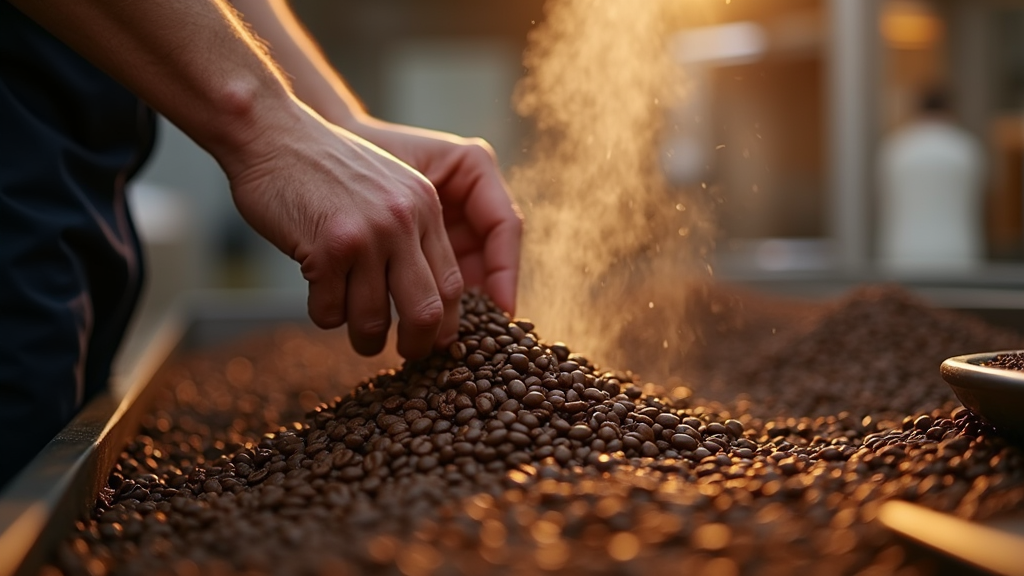Table of Contents
- Introduction
- Understanding Single-Origin Coffee
- Understanding Blended Coffee
- Key Differences Between Single-Origin and Blended Coffee
- Roasting and Brewing Considerations
- When to Choose: Recommendations
- Conclusion
Introduction

The World of Coffee: Exploring Single-Origin and Blends
Did you know that approximately two billion cups of coffee are consumed worldwide every day? This staggering number highlights the global love affair with this caffeinated beverage. But within this vast world of coffee, there exists a fascinating dichotomy: single-origin versus blended coffee. Both offer unique experiences, catering to different palates and preferences. This blog post will delve into the nuances of each, helping you navigate the exciting world of coffee.
Single-origin coffees showcase the distinct characteristics of a specific region, farm, or even a particular lot of beans. They are celebrated for their unique and often complex flavor profiles. Blended coffees, on the other hand, are a carefully curated mix of beans from different origins, designed to create a balanced and consistent flavor.
Why This Matters
Understanding the difference between single-origin and blended coffees is more than just a matter of taste; it’s about enhancing your overall coffee experience. By learning about flavor profiles and their origins, you can develop a deeper appreciation for the artistry and science behind each cup. Imagine being able to identify the subtle notes of berries in an Ethiopian Yirgacheffe or the chocolatey richness of a Sumatran Mandheling.
Furthermore, making informed choices about the coffee you consume can also support ethical and sustainable practices. Many single-origin coffees are sourced directly from farmers, ensuring fair prices and promoting environmentally friendly farming methods. By understanding where your coffee comes from, you can contribute to a more sustainable and equitable coffee industry.
What You’ll Learn
In this blog post, we will explore the world of single-origin and blended coffees in detail. By the end, you will:
- Define precisely what constitutes single-origin and blended coffee.
- Compare and contrast the flavor profiles of single-origin and blended coffees, highlighting their unique characteristics.
- Evaluate the consistency and traceability of each type, understanding the journey from farm to cup.
- Analyze the price differences between single-origin and blended coffees, considering the factors that contribute to these variations.
- Understand when to choose single-origin or blended coffee based on your personal preferences and the brewing method you intend to use.
Understanding Single-Origin Coffee
What is Single-Origin Coffee?
Single-origin coffee is exactly what it sounds like: coffee beans sourced from a single, identifiable geographical location. This could mean a specific country, a particular region within that country, or even a single farm or cooperative. The key is that the coffee’s origin is not blended with beans from other areas, offering a pure representation of its place of birth.
The importance of a single, identifiable source cannot be overstated. It allows coffee enthusiasts to trace the beans back to their roots, understanding the unique factors that contribute to their distinct flavor profiles. This traceability is a cornerstone of the single-origin experience, setting it apart from blended coffees.
Characteristics of Single-Origin Coffee
Single-origin coffees are celebrated for their unique and pronounced flavor profiles. These distinct flavors are heavily influenced by the environmental conditions in which the coffee plants are grown, including climate, altitude, soil composition, and the specific cultivation practices employed by the farmers.
For example, an Ethiopian Yirgacheffe is often characterized by its bright floral and citrus notes, while a Colombian Supremo might offer a smoother experience with chocolate and nutty flavors. A Sumatra Mandheling, on the other hand, often presents a more earthy and spicy profile. These differences highlight the significant impact of terroir on the final cup.
Traceability is another key characteristic. Because single-origin coffees come from a known source, there is greater transparency in the supply chain. This transparency makes it easier to ensure that the coffee is ethically and sustainably sourced, supporting the farmers and communities involved in its production.
Terroir, a term borrowed from the wine industry, plays a crucial role in shaping the flavor of single-origin coffee. The soil composition, altitude, and climate all contribute to the coffee’s unique characteristics. For instance, coffee grown at higher altitudes tends to produce denser beans with brighter acidity, while specific rainfall patterns can influence the bean’s overall flavor development.
Advantages of Single-Origin Coffee
The advantages of choosing single-origin coffee are numerous. First and foremost, the distinct flavor profile offers a unique and memorable tasting experience. Each region imparts its own signature to the beans, resulting in a cup that is unlike any other.
The greater transparency and traceability associated with single-origin coffees also appeal to ethically conscious consumers. Knowing where your coffee comes from and that it was produced in a sustainable manner provides added value and peace of mind.
Single-origin coffees offer an opportunity for flavor exploration and appreciation of regional nuances. Coffee lovers can embark on a sensory journey, discovering the subtle differences between coffees from various regions and developing a deeper understanding of the factors that influence their taste.
Ultimately, single-origin coffee offers a “theatrical experience,” linking the flavors in your cup to specific regions, people, and their unique traditions. It’s a chance to connect with the origins of your coffee in a way that blended coffees simply cannot provide.
Examples of Single-Origin Coffees
To further illustrate the diversity of single-origin coffees, here are a few notable examples:
- Ethiopian Yirgacheffe: Known for its delicate floral and bright citrus notes.
- Colombian Supremo: Offers a balanced cup with chocolate and nutty flavors.
- Sumatra Mandheling: Presents earthy and spicy notes with a full body.
- Kenyan AA: Characterized by bright acidity and black currant notes.
- Costa Rican Tarrazu: Delivers a balanced and clean cup with citrus and chocolate undertones.
Price Considerations
Single-origin coffees are often more expensive than blended coffees. This higher price point reflects the smaller-scale farming practices, the greater attention to detail required in their production, and the exclusivity associated with these unique beans.
The cost of single-origin coffee also takes into account the labor-intensive processes involved, from careful cultivation to meticulous harvesting and processing. By choosing single-origin coffee, you are supporting these dedicated farmers and their communities, while also indulging in a truly exceptional coffee experience.
Understanding Blended Coffee

What is Blended Coffee?
Blended coffee is a carefully crafted combination of coffee beans sourced from multiple regions, farms, and even countries. This isn’t just a random mix; it’s a deliberate process that combines both art and science to achieve a specific, unique flavor profile. Master blenders meticulously select beans with complementary characteristics, aiming to create a cup that’s greater than the sum of its parts.
The goal of blending is to create a harmonious and balanced flavor experience. By combining different beans, roasters can achieve a level of complexity and depth that might be difficult to achieve with a single-origin coffee.
Characteristics of Blended Coffee
Blended coffee offers a range of characteristics that make it a popular choice for many coffee drinkers.
-
Flavor Profile: One of the most notable characteristics is its balanced flavor. This balance is achieved by combining beans from different origins, each contributing its unique notes. For example, a blend might combine the bright acidity of South American beans with the earthy, fruity notes of African beans, resulting in a complex and satisfying cup.
-
Consistency: Blended coffee provides a more consistent flavor profile compared to single-origin coffees. Single-origin coffees can vary significantly from harvest to harvest due to changes in weather, soil conditions, and processing methods. Blending helps to mitigate these variations, ensuring a more predictable and reliable taste experience.
-
Versatility: Blended coffee is incredibly versatile and caters to a wide range of taste preferences. Whether you prefer a light and bright cup in the morning or a rich and bold espresso, there’s likely a blend that will suit your palate.
Flavor Profile: One of the most notable characteristics is its balanced flavor. This balance is achieved by combining beans from different origins, each contributing its unique notes. For example, a blend might combine the bright acidity of South American beans with the earthy, fruity notes of African beans, resulting in a complex and satisfying cup.
Consistency: Blended coffee provides a more consistent flavor profile compared to single-origin coffees. Single-origin coffees can vary significantly from harvest to harvest due to changes in weather, soil conditions, and processing methods. Blending helps to mitigate these variations, ensuring a more predictable and reliable taste experience.
Versatility: Blended coffee is incredibly versatile and caters to a wide range of taste preferences. Whether you prefer a light and bright cup in the morning or a rich and bold espresso, there’s likely a blend that will suit your palate.
Advantages of Blended Coffee
There are several advantages to choosing blended coffee, making it a favorite among both casual and serious coffee drinkers.
-
The consistent and balanced flavor profile of blended coffee makes it an excellent choice for espresso drinks. The blend’s complexity can stand up to milk and other additions, resulting in a well-rounded and flavorful beverage.
-
Blended coffee offers a wider range of flavors and characteristics, appealing to a broader audience. This makes it a great option for serving to guests or for those who are new to the world of specialty coffee.
-
For many, blended coffee provides a sense of comfort and predictability. Its consistent flavor profile makes it a reliable choice for everyday enjoyment.
-
Blended coffee is often more affordable compared to single-origin coffees, making it an accessible option for those on a budget.
The consistent and balanced flavor profile of blended coffee makes it an excellent choice for espresso drinks. The blend’s complexity can stand up to milk and other additions, resulting in a well-rounded and flavorful beverage.
Blended coffee offers a wider range of flavors and characteristics, appealing to a broader audience. This makes it a great option for serving to guests or for those who are new to the world of specialty coffee.
For many, blended coffee provides a sense of comfort and predictability. Its consistent flavor profile makes it a reliable choice for everyday enjoyment.
Blended coffee is often more affordable compared to single-origin coffees, making it an accessible option for those on a budget.
Examples of Coffee Blends
Many popular coffee blends are available, each with its unique characteristics and intended use.
-
Breakfast Blend: Typically a mild and smooth blend with a light to medium roast, perfect for starting the day.
-
French Roast: A dark roast with a bold and smoky flavor, ideal for those who prefer a strong and intense cup.
-
Espresso Blend: Designed specifically for espresso, this blend offers a balance of sweetness and acidity that stands up well to milk and other additions.
-
Mocha-Java: A classic blend of Yemen and Java coffees, known for its complex and chocolatey flavor profile.
Breakfast Blend: Typically a mild and smooth blend with a light to medium roast, perfect for starting the day.
French Roast: A dark roast with a bold and smoky flavor, ideal for those who prefer a strong and intense cup.
Espresso Blend: Designed specifically for espresso, this blend offers a balance of sweetness and acidity that stands up well to milk and other additions.
Mocha-Java: A classic blend of Yemen and Java coffees, known for its complex and chocolatey flavor profile.
Price Considerations
One of the practical advantages of blended coffee is its affordability.
-
Blended coffee is generally more affordable compared to single-origin coffees. This is because blenders can utilize a wider range of beans, including those that may not meet the stringent standards of single-origin offerings.
-
This cost-effectiveness makes blended coffee an excellent option for everyday consumption, allowing you to enjoy a delicious cup without breaking the bank.
Blended coffee is generally more affordable compared to single-origin coffees. This is because blenders can utilize a wider range of beans, including those that may not meet the stringent standards of single-origin offerings.
This cost-effectiveness makes blended coffee an excellent option for everyday consumption, allowing you to enjoy a delicious cup without breaking the bank.
Key Differences Between Single-Origin and Blended Coffee
Flavor Profile
* If you value traceability and exploring distinct flavors, opt for single-origin; if you prefer a reliable, cost-effective cup, blends are the way to go.
One of the most noticeable differences between single-origin and blended coffee lies in their flavor profiles. Single-origin coffees are celebrated for their distinct and unique flavors, which are heavily influenced by the terroir – the combination of environmental factors like soil, climate, and altitude of the region where the coffee is grown. This means you might taste floral notes from an Ethiopian Yirgacheffe or a bright, citrusy flavor from a Kenyan coffee.
Blends, on the other hand, are created by combining beans from different origins. The goal is to achieve a balanced and consistent flavor profile. Coffee blenders carefully select beans that complement each other, creating a harmonious cup that offers a reliable and familiar taste. While you might not experience the same level of nuanced flavors as with a single-origin, blends provide a well-rounded and approachable coffee experience.
Consistency
Consistency is another area where single-origin and blended coffees diverge. Blends are designed to offer a more consistent taste from batch to batch. By combining beans from various regions, blenders can mitigate the impact of seasonal variations or crop fluctuations that might affect a single-origin coffee. This makes blends a reliable choice for those who prefer a predictable cup every time.
Single-origin coffees, by their nature, can exhibit more variability. The characteristics of a single-origin coffee can change based on the specific farm, processing method, and even the time of year it was harvested. While this variability can be exciting for coffee enthusiasts who enjoy exploring different flavor nuances, it also means that the taste of your favorite single-origin coffee might not be exactly the same every time you brew it.
Traceability
Traceability refers to the ability to track the journey of your coffee beans from the farm to your cup. Single-origin coffees offer a higher degree of traceability because they come from a single source. Often, you can learn about the specific farm, farmer, and processing methods used to produce the coffee. This level of transparency allows you to connect with the origin of your coffee and appreciate the work that went into producing it.
Blends, because they combine beans from multiple origins, are inherently more difficult to trace. While roasters typically provide information about the regions where the beans were sourced, it’s usually not possible to pinpoint the exact farm or producer. This doesn’t mean that blends are inherently less ethical or sustainable, but it does mean that you have less direct information about the coffee’s journey.
Brewing Methods
The best brewing method for a particular coffee depends on its unique characteristics. Single-origin coffees, with their complex and nuanced flavors, often benefit from brewing methods that highlight these qualities. Pour-over methods, such as Hario V60 or Chemex, are popular choices because they allow you to carefully control the brewing process and extract the delicate flavors of the coffee. For single-origin coffees, a recommended coffee-to-water ratio is typically 22-24 grams of coffee per 350 grams of water, but adjustments can be made to suit individual preferences.
Blends, with their balanced flavor profiles, are generally more versatile and forgiving when it comes to brewing methods. They often perform well as espresso, providing a rich and creamy base for lattes and cappuccinos. The recommended coffee-to-water ratio for blends used in espresso is generally around 28-30 grams of coffee per 350 grams of water. However, blends can also be enjoyed using other brewing methods, such as drip coffee makers or French presses.
Price
Price is another factor to consider when choosing between single-origin and blended coffee. Single-origin coffees are typically more expensive than blends due to the specialized sourcing and higher quality standards associated with them. The limited availability of certain single-origin beans and the extra effort required to source them also contribute to their higher price tag.
Blends offer a more cost-effective option for coffee drinkers. By combining beans from different origins, roasters can create a delicious and balanced coffee at a more accessible price point. This makes blends a great choice for everyday coffee consumption without sacrificing quality or flavor.
Roasting and Brewing Considerations

Roasting Techniques
The art of roasting coffee beans is pivotal in unlocking their potential, and the approach often differs significantly between blends and single-origin coffees. Roasting transforms the green coffee beans, developing their flavors, aromas, and body. Understanding these nuances is key to a great cup.
Blends, especially those designed to emphasize chocolatey and sweet notes, often benefit from a darker roast profile. This technique is frequently employed when using washed-processed Latin American coffees, as it accentuates their inherent sweetness and creates a more robust, comforting flavor profile. The darker roast caramelizes the sugars within the bean, leading to a richer, more intense taste experience.
Single-origin coffees, on the other hand, offer a unique opportunity to showcase the distinct characteristics of a specific region, farm, or processing method. Roasting these beans requires a more delicate touch. The goal is to highlight the inherent qualities of the bean, whether it be a bright acidity, floral aroma, or fruity sweetness. Different single-origin coffees will require different roasting methods to optimize their flavor profiles, meaning the roaster needs to adjust variables like heat and time depending on the bean’s origin and desired outcome.
Brewing Suggestions
Once the coffee is expertly roasted, the brewing method becomes the final step in crafting the perfect cup. Different brewing techniques can drastically alter the final taste, so choosing the right method is crucial.
For those eager to truly understand their flavor preferences, the pour-over method is highly recommended. This manual brewing technique allows for greater control over the variables, enabling you to experiment with different grind sizes, water temperatures, and pour rates. By carefully observing the results, you can develop a deeper appreciation for the nuances of each coffee.
When brewing blends, it’s generally advisable to use a tighter water-to-coffee ratio compared to single-origin coffees. This typically results in a “heavier” cup, meaning a more concentrated flavor and fuller body. The exact ratio will depend on the specific blend and your personal preferences, but starting with a slightly lower water ratio is a good starting point.
Regardless of the brewing method or type of coffee, maintaining the correct water temperature is essential for optimal extraction. The ideal water temperature range is between 195-205°F (90-96°C). Brewing with water that is too cool can lead to under-extraction, resulting in a sour or weak cup. Conversely, water that is too hot can cause over-extraction, leading to a bitter or astringent taste. Using a thermometer to monitor the water temperature will ensure a consistently delicious brew.
When to Choose: Recommendations
Preference and Method
The choice between single-origin and blended coffee often boils down to personal preference and your intended brewing method. Single-origin coffees are celebrated for their distinctive regional flavors, showcasing the unique terroir of a specific farm or cooperative. If you’re seeking a coffee with bright acidity, complex aromas, and a story to tell, single-origin is an excellent choice. Furthermore, single-origin coffees offer greater traceability, allowing you to understand exactly where your beans came from and how they were processed.
Blends, on the other hand, are crafted to deliver a consistent and balanced flavor profile. Roasters carefully select and combine beans from different origins to achieve a desired taste. This makes blends particularly well-suited for espresso, where consistency is key. Blends often offer a broader range of flavors, combining the best characteristics of different beans into a harmonious cup.
Supporting Sustainability
Regardless of whether you choose single-origin or a blend, it’s crucial to support ethically and sustainably sourced coffee. The coffee industry can have significant environmental and social impacts, so making informed purchasing decisions is essential. Look for certifications like Fair Trade, Rainforest Alliance, or coffees sourced through direct trade relationships. These certifications indicate that the coffee was produced in a way that protects the environment, supports fair labor practices, and empowers farming communities.
By choosing sustainably sourced coffee, you’re not only enjoying a delicious cup but also contributing to a more equitable and environmentally responsible coffee industry. Supporting small farmers and roasters who prioritize sustainability helps to ensure the long-term viability of coffee production and the well-being of the people who depend on it.
Finding Your Preference
The best way to determine your preference between single-origin and blended coffee is to simply try both! Sample a variety of coffees from different origins and blends to discover the flavors you enjoy most. Pay attention to the aroma, acidity, body, and overall taste of each coffee. Take notes on what you like and dislike to help you refine your palate and identify your preferred flavor profiles.
Experimentation with different brewing methods can also significantly impact the taste of your coffee. A single-origin coffee brewed in a French press may yield a different flavor profile than the same coffee brewed as a pour-over. Similarly, a blend that shines as espresso might not be as enjoyable when brewed as a drip coffee. Don’t be afraid to try different brewing methods and adjust your grind size and water temperature to optimize the taste of each coffee. Through exploration and experimentation, you’ll uncover your personal preferences and unlock the full potential of both single-origin and blended coffees.
Conclusion

Recap of Key Differences
Throughout this exploration, we’ve uncovered significant distinctions between single-origin and blended coffees. Single-origin coffees shine with their unique, terroir-driven flavors, offering a direct line to a specific farm or region. Their consistency can vary from season to season, adding to their allure for adventurous palates. Traceability is a major strength, allowing consumers to connect directly with the source of their beans. However, this exclusivity often comes at a higher price point.
Blended coffees, on the other hand, excel in delivering a consistent and balanced flavor profile year-round. This predictability is achieved by combining beans from various origins, carefully crafted to create a harmonious cup. While traceability might be less specific, blends often offer a more accessible price point, making them a practical choice for everyday enjoyment. Each type offers unique benefits, catering to different priorities and preferences.
Future Trends
The future of coffee looks bright, with a growing appreciation for both single-origin and blended varieties. Consumers are becoming more educated and discerning, seeking out coffees that align with their values and taste preferences. We anticipate a continued rise in the popularity of single-origin coffees as more people seek unique and experiential coffee encounters. Simultaneously, expertly crafted blends will maintain their appeal, offering consistent quality and value.
Furthermore, the coffee industry is increasingly focused on sustainability and ethical sourcing. Consumers are demanding transparency and accountability, pushing roasters and producers to adopt environmentally friendly practices and ensure fair treatment of farmers. This trend will likely lead to more single-origin and blended coffees that are certified organic, Fair Trade, or sourced through direct trade relationships, benefiting both the environment and the communities that produce our beloved beverage.
Final Thoughts
Ultimately, the “best” coffee – whether single-origin or blended – is a matter of personal preference. We encourage you to embark on your own coffee journey, exploring the diverse flavors and characteristics that each type has to offer. Experiment with different brewing methods, from pour-over to espresso, to discover how they interact with the unique profiles of single-origin and blended coffees.
Whether you’re drawn to the nuanced complexity of a single-origin Ethiopian Yirgacheffe or the comforting familiarity of a well-balanced house blend, there’s a world of coffee waiting to be discovered. Embrace the adventure, trust your palate, and enjoy the deliciousness that awaits!

